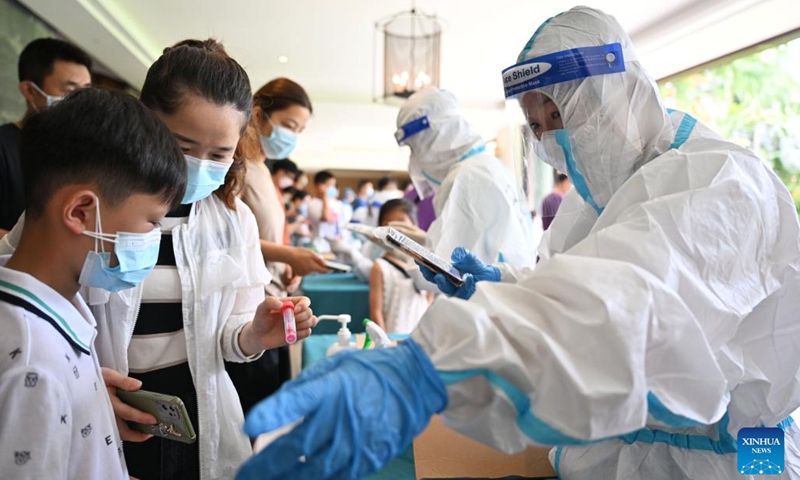Situation still grim, major tourist destinations affected
China grappled with fresh COVID-19 flare-ups with daily cases across 17 provincial-level regions surpassing an unprecedented 2,000 on Sunday, with a high level of virus transmission notably coming from three major tourist destinations – Northwest China’s Xinjiang Uygur Autonomous Region, Southwest China’s Xizang Autonomous Region and South China’s Hainan Province.
Saturday saw 623 confirmed and 1,844 asymptomatic cases scattered across 17 provincial-level regions. Hainan reported the most daily COVID-19 cases at 1,340, while Xizang and Xinjiang regions reported 502 and 398 positive cases respectively, according to data compiled by the National Health Commission.
Health experts reached by the Global Times attributed the high daily surge to the active measures against COVID-19 taken across epidemic-hit regions. They said that without the dynamic zero-case policy, which stresses “four early” measures – early detection, early reporting, early quarantine, and early treatment of COVID-19 cases – the daily increase would be much higher as this wave of outbreaks comes during the peak tourism season and tourists’ movements would have multiplied the COVID-19 presence in cities.
Experts also noted that the relatively poor resources in border regions such as Xinjiang and Xizang could also be one of the reasons complicating the outbreak, but they believed the resurgence would soon be tamed after experiencing a certain high period following the country’s assistance gradually being put in position.
In the two weeks since August 1, Hainan registered a total of 7,736 positive cases. At Sunday’s press conference, one official from the Hainan provincial government clearly categorized local outbreaks across cities – Sanya’s outbreak is in a high plateau period of fluctuation, and the rising momentum has been effectively curbed.
Aid teams from outside the province sent to epidemic-hit regions were allocated based on anti-COVID-19 requirements, the official said. So far, the island has seen more than 17,000 people coming to help.
At the same time, Xinjiang registered a total of five confirmed patients and the tally of silent carriers came to 2,034, according to the Saturday press briefing. There are four transmission chains and they are independent from each other. The rapidly transmitted virus has spread to 13 regions within Xinjiang.
Adding to the difficulties, outbreaks in multiple places in Xinjiang region are still developing and social transmissions have yet to be cut off, a local official said at Saturday’s press briefing.
The COVID-19 scenario in Xizang is also looking grim. Wang Taobi, an official from the Xizang regional health commission, told Sunday’s press conference that as of Sunday noon, the whole of Xizang had registered 947 positive cases, made up of 99 confirmed and 848 asymptomatic cases.
Wang explained that the high daily increase in Xizang is due to the new adjustment of not reviewing people who were positive in preliminary tests, as well as stronger nucleic acid testing capabilities.
In addition to the hardest-hit Hainan, Xinjiang and Xizang, the Global Times found that more popular tourism destinations such as Northwest China’s Gansu, Qinghai have been affected by sporadic cases. Cities such as Dunhuang where the renowned Mogao Grottoes are located have imposed static management.
A senior expert from the Chinese Center for Disease Control and Prevention told the Global Times on Sunday that the country is sticking to a policy of striking a better balance between economic development and epidemic control, so that with the COVID-19 epidemic yet to be over, it is normal that COVID-19 resurgences with mutated variants tend to be more contagious. The large numbers of cases from the recent waves of COVID-19 flare-ups in Xinjiang, Xizang or Hainan are a direct result of tourists’ influx due to China’s booming tourism market during the summer.
The expert said the high daily surge is not necessarily a bad thing because it indicated the effectiveness of recent anti-epidemic measures. The number should have been much higher given the numbers of visitors in epidemic-hit regions, the expert said, assuring the public that this round of outbreaks in the country’s popular tourist destinations will eventually be brought under control. However, judging from recent daily recorded cases, it will still take a certain amount of time before the trend goes down, he said.
Lu Hongzhou, head of the Third People’s Hospital of Shenzhen, also held a positive attitude toward the COVID-19 resurgence, saying that as long as the virus presence is detected in one place, the country is able to control it. Compared with other cities that were frequently hit by the coronavirus such as Shenzhen, Xinjiang and Xizang are relatively lacking in experience and medical resources. The joint aid from other provinces will help them address the outbreaks soon, Lu said.
Though the COVID-19 flare-up has hit tourism destinations hard, they have managed to evacuate stranded tourists to the greatest extent possible. Observers viewed it as a positive trend as part of the country’s efforts to optimize the dynamic zero-case policy and make it more science-based and precise.
Hainan has sent more than 14,240 stranded tourists back home on 92 flights as of Sunday morning and the commercial operation of domestic passenger flights at Sanya Phoenix International Airport will be resumed in an orderly manner starting from Monday, in a latest move to evacuate more stranded tourists back home.
Over 2,000 tourists were still stranded in Xinjiang as of Saturday evening, with over 92,000 having already been evacuated from the region’s 15 5A-level scenic spots since August 2. Xizang had added 12 more train services to take stranded tourists and so far 193 tourists have left the region.
(Global Times)




